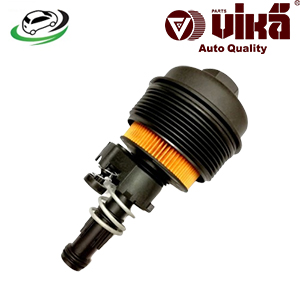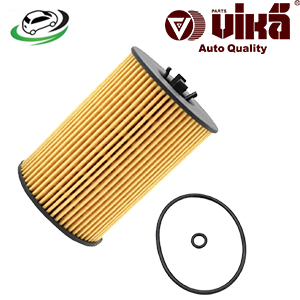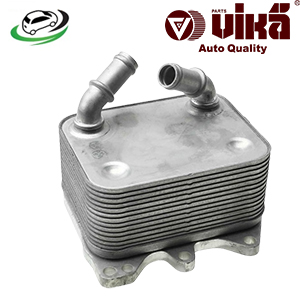-4%
Get Engine Oil Cooler VW Atlas 3.6L V6/ Atlas Cross Sport 2.0L A/T/ Atlas Cross Sport 3.6L V6/ CC 3.6L V6 A/T/ Passat 3.6L V6 03H117021D
The engine oil cooler is an essential component in modern internal combustion engines, designed to regulate the temperature of the engine oil. By ensuring that the oil stays within an optimal temperature range, the oil cooler plays a critical role in maintaining engine performance, preventing overheating, and extending the engine’s lifespan. This device is especially important in high-performance vehicles, heavy-duty applications, and engines operating in extreme conditions.
1. Design and Structure
An engine oil cooler is essentially a small radiator-like device that facilitates heat exchange. It is typically composed of the following elements:
- Cooling Fins: Similar to a radiator, the oil cooler has a series of cooling fins that dissipate heat from the engine oil as it passes through the cooler.
- Oil Passages: Inside the cooler, there are narrow passages or tubes through which the engine oil flows. These passages are designed to maximize the surface area in contact with the cooling fins, enhancing heat dissipation.
- Inlet and Outlet Ports: The oil cooler has an inlet and an outlet port for oil. The inlet connects to the engine’s oil circulation system, while the outlet returns cooled oil to the engine.
- Mounting Brackets: The cooler is securely mounted to the vehicle’s frame or engine compartment using brackets. It is often positioned in an area with good airflow, such as behind the grille or near the radiator.
The materials used in oil coolers vary, but they are commonly made of aluminum due to its excellent thermal conductivity, lightweight properties, and resistance to corrosion.
2. Functionality
The primary function of an engine oil cooler is to reduce the temperature of the engine oil, ensuring that it remains within a safe operating range. Engine oil serves multiple functions: it lubricates moving parts, reduces friction, cleans the engine, and helps dissipate heat. However, as oil circulates through the engine, it absorbs heat and can become too hot, losing its ability to effectively lubricate and protect the engine.
How the Engine Oil Cooler Works:
- Oil Circulation: Engine oil is pumped from the oil sump through the oil filter and into the engine’s lubrication system. A portion of this oil is diverted to the oil cooler through the inlet port.
- Heat Dissipation: As the oil passes through the cooler’s narrow passages, heat is transferred from the oil to the cooler’s fins. Airflow over the fins (from vehicle movement or a fan) dissipates the heat into the atmosphere.
- Cooled Oil Returns: After passing through the cooler, the now-cooled oil is returned to the engine via the outlet port, where it continues to lubricate and cool the engine components.
This process is continuous, ensuring that the engine oil maintains a stable temperature even under heavy loads, high speeds, or extreme environmental conditions.
3. Importance in Engine Operation
The engine oil cooler is critical for maintaining the health and performance of an engine, particularly under demanding conditions. Here’s why it’s so important:
- Prevents Overheating: By keeping the oil temperature in check, the cooler prevents the engine from overheating, which can cause severe damage to internal components, such as pistons, bearings, and cylinder walls.
- Maintains Oil Viscosity: Engine oil needs to remain within a specific viscosity range to function effectively. If the oil gets too hot, it becomes too thin and loses its lubricating properties, leading to increased wear and tear on the engine.
- Extends Engine Life: By preventing overheating and maintaining proper lubrication, the oil cooler helps extend the life of the engine. This is especially important in high-performance or heavy-duty engines that operate under extreme conditions.
- Improves Engine Efficiency: A cooler, well-lubricated engine operates more efficiently, which can lead to better fuel economy and overall performance.
4. Types of Engine Oil Coolers
There are several types of engine oil coolers, each designed for specific applications and operating conditions:
- Air-Cooled Oil Cooler: The most common type, this cooler uses ambient air to dissipate heat. It is typically mounted in front of the radiator or in a location with good airflow. Air-cooled oil coolers are effective in most passenger vehicles and light trucks.
- Liquid-Cooled Oil Cooler: In this design, the oil cooler uses the engine’s coolant to absorb heat from the oil. The coolant then passes through the vehicle’s radiator, where it is cooled before circulating back into the engine. Liquid-cooled oil coolers are often used in heavy-duty vehicles or high-performance engines where more efficient cooling is required.
- Stacked Plate Oil Cooler: This type consists of a series of stacked plates with oil passages running between them. The design maximizes surface area for heat exchange and is commonly used in high-performance or racing applications where superior cooling is necessary.
- Tube-and-Fin Oil Cooler: In this design, oil passes through tubes surrounded by fins, which help dissipate heat. This type of cooler is efficient and compact, making it suitable for a wide range of vehicles.
5. Common Issues and Maintenance
While oil coolers are generally durable, they can encounter several issues, particularly if not properly maintained:
- Leaks: Over time, the oil cooler or its connections can develop leaks, leading to oil loss. This is often caused by corrosion, physical damage, or degraded seals and gaskets. Oil leaks can lead to insufficient lubrication and potential engine damage.
- Blockages: The narrow passages in the oil cooler can become clogged with sludge, debris, or metal shavings, particularly if the engine oil is not changed regularly. Blockages reduce the cooler’s efficiency and can cause the oil to overheat.
- Corrosion: In vehicles exposed to harsh environments, such as salty roads or coastal areas, the oil cooler can corrode, especially if it’s made of aluminum. Corrosion weakens the cooler and can lead to leaks or failure.
- Cooling Inefficiency: Over time, the cooling fins can become clogged with dirt, debris, or bugs, reducing the cooler’s efficiency. This issue is more common in air-cooled oil coolers.
Maintenance Tips:
- Regular Oil Changes: Regular oil changes are essential to prevent sludge and debris from clogging the oil cooler. Clean oil also enhances the cooler’s efficiency.
- Inspect for Leaks: Periodically inspect the oil cooler and its connections for signs of oil leaks. Early detection can prevent more serious engine problems.
- Clean the Cooler: For air-cooled oil coolers, regularly clean the cooling fins to remove dirt, bugs, and debris. This helps maintain airflow and cooling efficiency.
- Check the Mounting: Ensure that the oil cooler is securely mounted and that there are no loose connections or brackets, which could lead to vibrations and eventual failure.
6. Replacement and Repair
If the oil cooler becomes damaged or fails, it usually needs to be replaced, as repair is often not feasible. The replacement process involves several steps:
- Drain the Oil: Before replacing the oil cooler, the engine oil must be drained to prevent spillage and ensure a clean working environment.
- Remove the Old Cooler: The old cooler is unbolted from its mounting points, and the oil lines are disconnected. This may require removing other components to gain access, depending on the vehicle’s design.
- Install the New Cooler: The new oil cooler is installed in place of the old one, ensuring that all connections are secure and that the cooler is properly mounted. New seals or gaskets should be used to prevent leaks.
- Refill the Oil: After installation, the engine oil is refilled, and the vehicle is started to check for leaks and ensure proper operation.
7. Performance and Aftermarket Options
For performance enthusiasts or those with vehicles operating in extreme conditions, aftermarket oil coolers offer several advantages:
- Increased Cooling Capacity: Aftermarket oil coolers often provide better cooling performance, with larger surface areas and more efficient designs.
- Durability: High-performance oil coolers are typically made from stronger materials and designed to withstand higher pressures and temperatures.
- Custom Fit: Many aftermarket coolers are designed for specific vehicle models, ensuring a perfect fit and optimal performance.
Follow us on Facebook for more parts.



